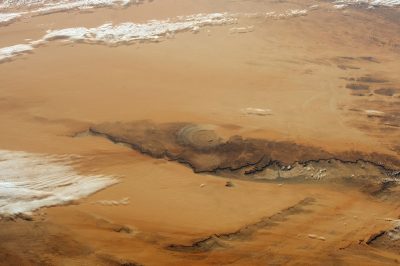Eye of the Sahara and Africa’s Mythical Wonders of Nature

Eye of the Sahara is one of Africa’s most stunning natural legends (Image: Wiki Commons)
Unveiling Africa’s Natural Wonders: Where Myth Meets Modern Science
Africa is a continent of unparalleled biodiversity, rich culture, and deep, enduring mystery. For centuries, its most stunning natural landmarks have inspired myths, legends, and a sense of the supernatural. From massive formations visible from space to water that flashes with spectral light, the continent holds secrets that science is finally unlocking. Come with us on a journey to explore the true stories behind some of the most captivating African mysterious phenomena.
The Eye of the Sahara: Is it Atlantis?
Hidden deep within the Mauritanian sands of the Sahara Desert is the Richat Structure, more famously known as the Eye of the Sahara. This colossal, circular formation, spanning over 25 miles in diameter, is so distinctive it has been used as a landmark by astronauts since the Gemini missions. Its perfect concentric circles immediately fueled one of the greatest modern myths: that it is the remains of the lost city of Atlantis described by Plato.
The Science:
Despite its alien, manufactured appearance, the Richat Structure is entirely terrestrial. It is not an impact crater, but a deeply eroded geological dome. Geologists theorize that it formed millions of years ago when molten rock surged beneath the crust, uplifting the overlying sedimentary layers. Over time, erosion by wind and water wore away the different rock types (sandstone, quartzite, and volcanic rock) at varying speeds, sculpting the spectacular concentric rings we see today. The Eye of the Sahara is a rare and powerful demonstration of Earth’s slow, persistent geological processes.
The Sea Ghosts: Glowing Oceans of Kenya & Mozambique
Imagine sailing across the Indian Ocean when the water around your boat begins to glow with an ethereal, blue-green light. This spectacular sight, seen off the coasts of nations like Kenya and Mozambique, has long been interpreted as a supernatural event; perhaps the flash of sea ghosts or the reflection of a hidden underwater kingdom.
The Science:
The real magic is biological. This stunning light is known as bioluminescence, the product of a chemical reaction within living organisms. The glow is primarily caused by immense blooms of microscopic marine life called dinoflagellates. When disturbed by waves, a boat, or a swimmer, these tiny creatures flash, turning vast expanses into a living light show.
Dallol’s Deadly Beauty: The Blue Fire of Ethiopia
The Danakil Depression in Ethiopia is one of the hottest and most geologically alien places on Earth. Within this landscape lies Dallol, a hydrothermal field famous for its violently vibrant, acid-saturated pools. Locals and early explorers viewed this landscape (with its sulfurous odors and boiling springs) as a portal to hell or a cursed land.
The Science:
Dallol is an explosive, halo-volcanic complex powered by hydrothermal activity. Underground magma heats mineral-rich water, creating brine pools and towering salt spires. The incredible array of colors (yellow, red, green, and the occasional blue hue) is due to the intense concentration and oxidation of various salts and minerals, including iron and sulfur compounds.
The Nuclear Mystery: The Oklo Phenomenon (Gabon)
In the early 1970s, scientists discovered something extraordinary in the Oklo uranium mine in Gabon: the uranium ore was depleted of the fissile isotope U-235. Initially, this sparked wild speculation that an advanced, ancient civilization had once used this ore.
The Science:
Oklo is the site of the world’s only known natural nuclear fission reactor. About two billion years ago, the natural concentration of U-235 was high enough (around 3%) to spontaneously sustain a nuclear chain reaction. Groundwater seeped into the deposit, acting as a crucial neutron moderator. The reactor ran intermittently for hundreds of thousands of years, self-regulating and powered entirely by nature.
The Thundering Water’s God: Nyami Nyami and Devil’s Pool
The mighty Victoria Falls, known locally as Mosi-oa-Tunya (“The Smoke That Thunders”), is one of the world’s most spectacular waterfalls. The Tonga people revere the Zambezi River as the home of Nyami Nyami, the powerful River God, a serpent-like deity whose wrath is blamed for floods, landslides, and the thunderous roar of the falls.
Perilously situated right on the lip of the falls is the infamous Devil’s Pool. Tourists risk a dip here, peering over the edge of the 350-foot drop. The name itself suggests a dangerous, mystical entity guarding the abyss.
The Science:
Victoria Falls formed through the erosion of soft sedimentary rock along a series of parallel faults and fracture zones, a process that continues today. The Devil’s Pool is simply a large, natural erosion feature carved into the basalt rock on the Zambian side of the falls. During the dry season (typically August to December), the river flow is low enough that a robust natural rock lip acts as a barrier, separating the calm pool water from the catastrophic drop, turning the terrifying chasm into the ultimate natural infinity pool.
The Geopolitical Anomaly: Bir Tawil’s Unclaimed Land
The region commonly referred to as the Forgotten Well of Sudan (Bir Tawil) captures the imagination as one of the few patches of truly “unclaimed” land on Earth.
The Science:
The mystery here is geopolitical. Bir Tawil is a small, uninhabited patch of land between Egypt and Sudan. Because both nations claim the much more strategically valuable Hala’ib Triangle, neither country is willing to claim the adjacent, resource-poor Bir Tawil. To claim it would be to tacitly acknowledge the other country’s border claim in the Hala’ib Triangle. It remains a fascinating anomaly of international law, perpetually unclaimed.
Africa continues to hold boundless wonders, where every legend, from the Eye of the Sahara to the Zambezi’s roar, has a spectacular scientific explanation waiting to be discovered.
Recommended:
